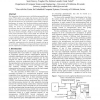Free Online Productivity Tools
i2Speak
i2Symbol
i2OCR
iTex2Img
iWeb2Print
iWeb2Shot
i2Type
iPdf2Split
iPdf2Merge
i2Bopomofo
i2Arabic
i2Style
i2Image
i2PDF
iLatex2Rtf
Sci2ools
DATE
2007
IEEE
2007
IEEE
Two-level microprocessor-accelerator partitioning
The integration of microprocessors and field-programmable gate array (FPGA) fabric on a single chip increases both the utility and necessity of tools that automatically move software functions from the microprocessor to accelerators on the FPGA to improve performance or energy. Such hardware/software partitioning for modern FPGAs involves the problem of partitioning functions among two levels of accelerator groups – tightly-coupled accelerators that have fast single-clock-cycle memory access to the microprocessor’s memory, and loosely-coupled accelerators that access memory through a bridge to avoid slowing the main clock period with their longer critical paths. We introduce this new two-level accelerator-partitioning problem, and we describe a novel optimal dynamic programming algorithm to solve the problem. By making use of the size constraint imposed by FPGAs, the algorithm has what is effectively quadratic runtime complexity, running in just a few seconds for examples with up ...
DATE 2007 | Field-programmable Gate Array | Hardware | Loosely-coupled Accelerators | Such Hardware/software Partitioning |
Related Content
| Added | 02 Jun 2010 |
| Updated | 02 Jun 2010 |
| Type | Conference |
| Year | 2007 |
| Where | DATE |
| Authors | Scott Sirowy, Yonghui Wu, Stefano Lonardi, Frank Vahid |
Comments (0)

